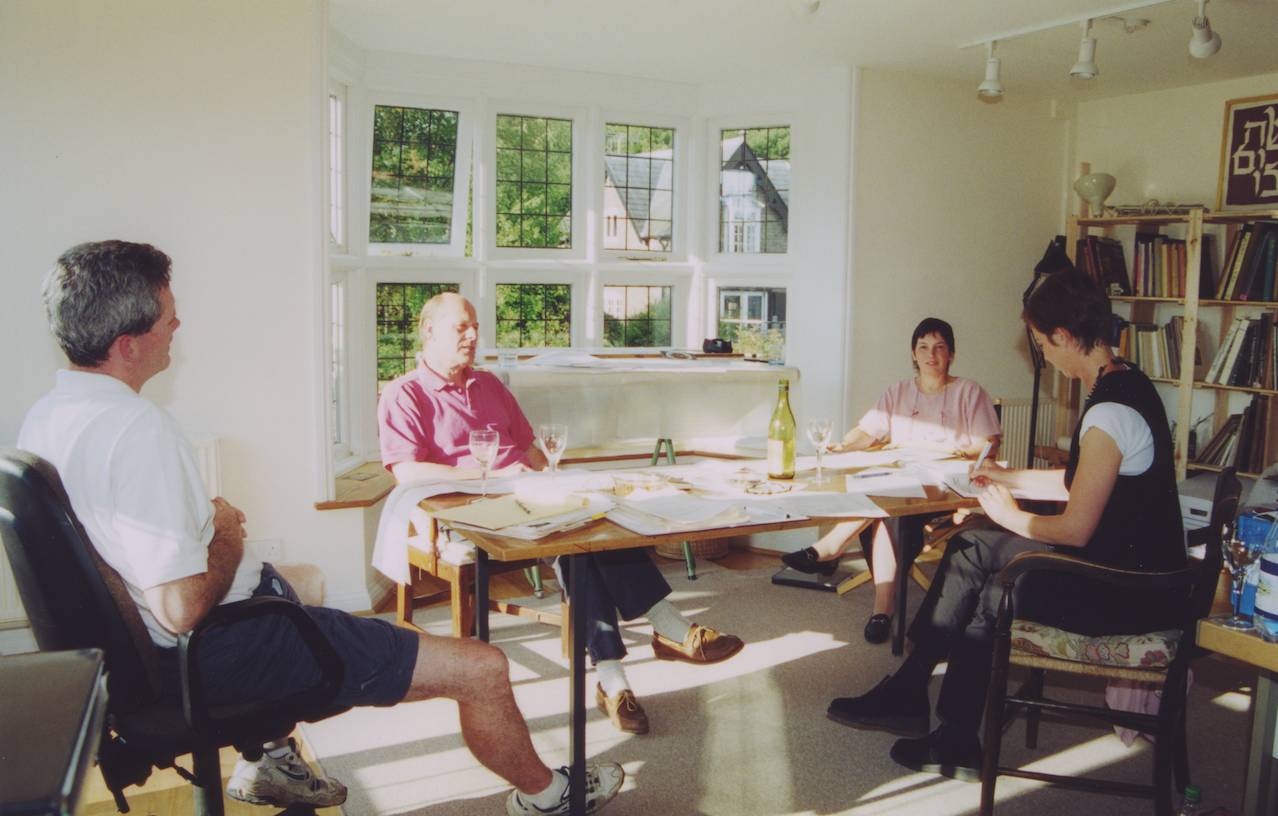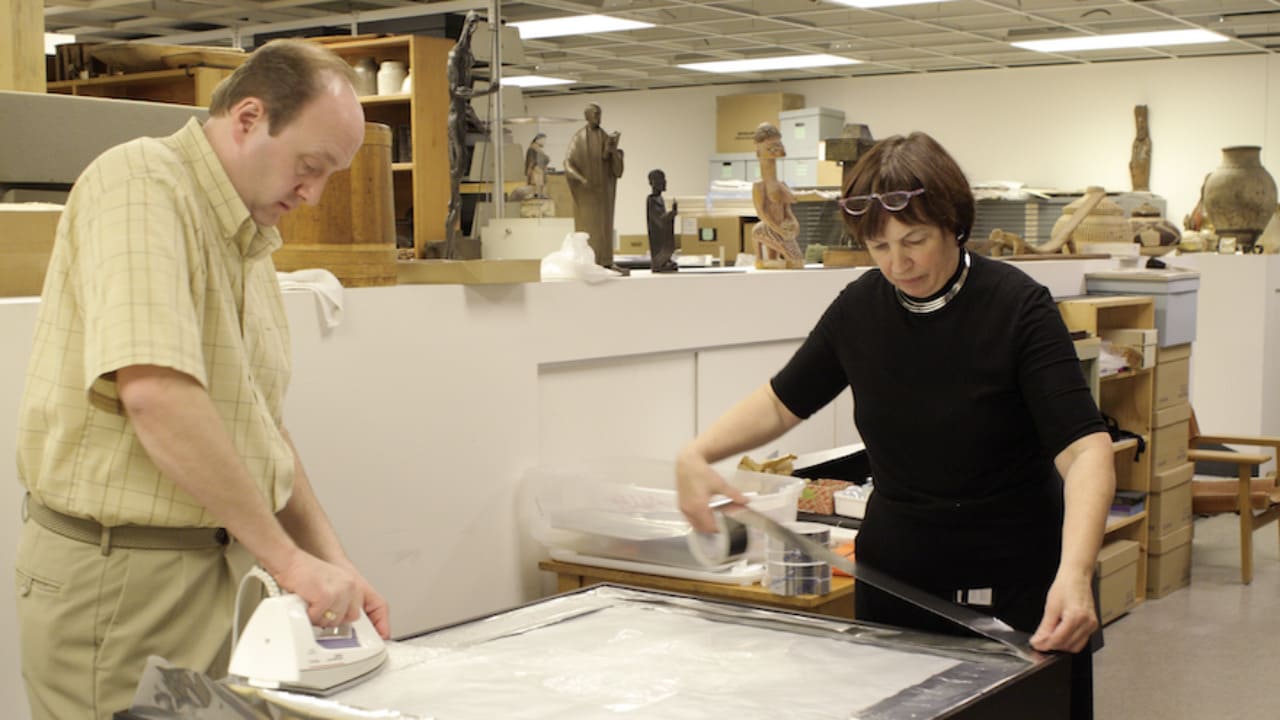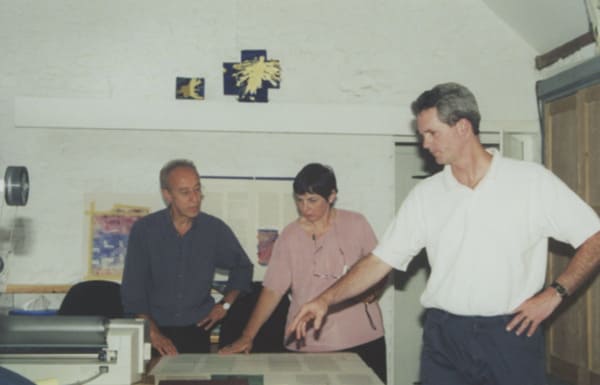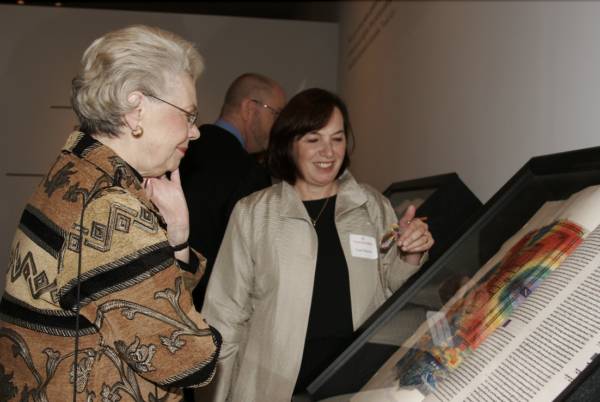The Women of The Saint John’s Bible: Carol Marrin, the Compass that Pointed True North
The Saint John’s Bible would not be what it is today without Carol Marrin’s sure leadership and ability to keep sailing through rocky waters.
They say The Saint John’s Bible is a conversation. Well, if Donald Jackson started the conversation, Carol Marrin is the one who facilitated it.
“Carol was the person who took all of the puzzle pieces and put them together,” said Tim Ternes, Director of The Saint John’s Bible at the Hill Manuscript Museum & Library and Marrin’s successor. “She could see the project from a bird’s eye view, then dive in and move the pieces. She could see where we were heading and take us there.”
This project, perhaps more than most, absolutely necessitated a once-in-a-lifetime leader such as Marrin. After all, it was full of disparate pieces. There was the world-renowned artist that started it all, Donald Jackson; there was the team of talented scribes, illuminators, and scriptorium members; there was the team of theological academics known as the Committee on Illumination & Text (CIT); there was the team of development professionals and organizers at Saint John’s University, and everyone in between. Also between them was a literal ocean, as most of the project’s artists lived in the United Kingdom.

It took someone like Marrin, who had kindness, empathy, and exacting direction to bridge the waters between the scholars and artists. Indeed, many say that the project would not have been completed if it were not for her leadership and political liaising.
“Carol was a visionary and a doer,” said Linda Orzechowski, Executive Assistant at the Hill Manuscript Museum and Library, and administrative assistant under Marrin for The Saint John’s Bible. “I honestly think that’s a unique combination. Some visionaries don’t know how to put their vision into practice. She put it into practice and made it happen.”

“She was driven to make things happen,” continued Orzechowski. “She was driven to serve people. She was a true servant leader in that definite sense. She saw her role as being the conduit between artist and commissioner. I always marveled at her ability to do so.”
Before the Bible
Before assuming the position of Director of The Saint John’s Bible in September 2000, Marrin was the Director of Bookstores for Saint John’s University and the College of Saint Benedict (CSBSJU) for many years. “Because of her work with the bookstore, she knew everybody on campus and everybody knew her,” said Ternes. “She knew the political ins and outs, and she just loved campus, and the campus community loved her. So, she was the perfect person to get this project started.”
During that time, Marrin also served on the Bible planning task force in 1998, and then as chair of the Bible Council in 1998 and 1999. “She loved books and loved reading. She understood the bigness and the significance of this project from the very beginning,” said Ternes.

Sewing the Seam
During Marrin’s time on campus, she became an inextricable part of the fabric of the University. Everywhere she went, people recognized her. Whether she was walking into the dining hall, President’s Office, or Abbey Woodworking, each stop took measurably longer than average, so Marrin could say hello to all of the people she knew – and didn’t.
“The Bible by its very nature is communal, and so is Saint John’s,” said Ternes. “For Carol, it was all about relationships with other humans. She had outstanding relationships with every person she worked with on the campus.”
“Carol really was a part of the communal fabric of this place,” continued Ternes. “She loved its beauty, she had respect for the physical place, and she loved the Benedictine tradition that you welcome people and that your life is a focus of work and prayer and beauty. I know she appreciated that.”

Of course, there were hard days when the fabric seemed ruffled. On those days, Marrin and Ternes had a tradition to make it through. The two had a bottle of whiskey that had been left at the office by Donald Jackson, which Marrin kept in her cupboard. Whenever a day was hard or strenuous, one of them would grab the bottle and simply place it on the other’s desk. Conversely, if one knew the other was having a hard day, they would place the bottle on the other’s desk as if to say, “I see you’re struggling today. I support you.” Neither party ever drank from the bottle. It was a silent symbol of care.
“She wanted people to be the best they could be, and she seemed to have a knack for seeing that in the other people, and then encouraging it out,” said Orzechowski. “I think she knew early on that Tim would be the person to pick up after her. She was so wise because she could just see the potential in people. It was a gift.”
What’s in a Legacy?
Marrin retired as Director in 2007, leaving Ternes to take her place. Marrin passed away in 2011 while Ternes was in London collecting the final, finished volume of The Saint John’s Bible, but not before her husband read her a letter sent to her by Ternes. In the letter, Ternes let her know that the project was finished. In it, he wrote, “It will be impossible to fill your shoes, so I’m not even going to try. I’m simply going to cobble a new pair.”

If you ask Ternes, Orzechowski, and pretty much anyone else on campus – they will tell you that Marrin’s spirit never left. Even more than a decade after her passing, Ternes and Orzechowski still ask themselves “What would Carol do?” Sometimes, they don’t have to wonder. Because so many of Marrin’s notes were handwritten, the pair still find her notes in files and archives.
“She’s very much still here,” said Ternes. “I still think of her as the wisdom woman of The Saint John’s Bible. She imparted so much wise counsel onto me that I still live by. She taught me that it’s not about you, it’s about your role in the project. Carol wanted the Bible to become part of the community and the world, not just a museum piece, not just something stuck on a shelf, but something that invited people to come together for centuries to come and it is.”
Marrin’s legacy also lives on in her husband, K.C. Marrin, an organ builder at Saint John’s University, who is as much a light and a part of the campus fabric as Marrin. She also lives on in a solid silver pendulum that occasionally hangs from Orzechowski’s neck. Marrin bought the gift, which holds a stone speckled with purple, brown, and pink, in London, citing that the necklace reminded her of Orzechowski.

The Women of The Saint John’s Bible
To read more stories similar to this one, visit The Saint John’s Bible Heritage Program blog and subscribe to our monthly e-newsletter, Sharing the Word.

